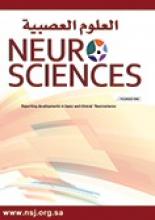Abstract
OBJECTIVE: To determine the more common symptoms of mental illness among Saudi adult primary health care (PHC) patients, and to apply the factor analysis of the Rahim Anxiety and Depression (RAD) Scale.
METHODS: This is a cross-sectional study of a sample of 641 patients that attended the PHC clinics in Al-Kharj city, from July to November 2000. Their ages ranged from 15 to 65 years. The RAD Scale was used as a self-administrating questionnaire to explore the common symptoms of mental illness. A factor analysis was performed by principle component analysis with varimax rotation of RAD Scale, with an eigen value of >1.5 for factor extraction. Only those items loading >0.4 were included.
RESULTS: A total of 609 patients with the mean age + SD of 33.7+13.4 responded, and of these men formed 46.6%. The most common mental illness symptoms were getting angry easily (46%), tension (35%), sleeping badly (27%), not enjoying daily activities (15%), and unhappiness (14%). Physical symptoms reported were headaches (43%), joint pains (38%), fatigue (36%), stomach problem (33%), and dizziness (27%). All the 39 items of the RAD Scale were included for factor analysis. Five factors (groups) were generated, which together accounted for 47% of the total variance. These factors were represented as: psychic depressive, psychic and somatic (headache and bodily pains) anxiety symptoms, somatization in the form of gastrointestinal complaints, somatization in the form of cardio-respiratory symptoms, and somatic anxiety symptoms.
CONCLUSION: Both physical and psychological symptoms of mental illness are a burden on the PHC patients. Consequently, using the RAD scale is helpful in diagnosis. The factor analysis categorizes the items into different groups to save time and specify the disorder. This will be a simplified method in the PHC settings.
- Copyright: © Neurosciences
Neurosciences is an Open Access journal and articles published are distributed under the terms of the Creative Commons Attribution-NonCommercial License (CC BY-NC). Readers may copy, distribute, and display the work for non-commercial purposes with the proper citation of the original work.






